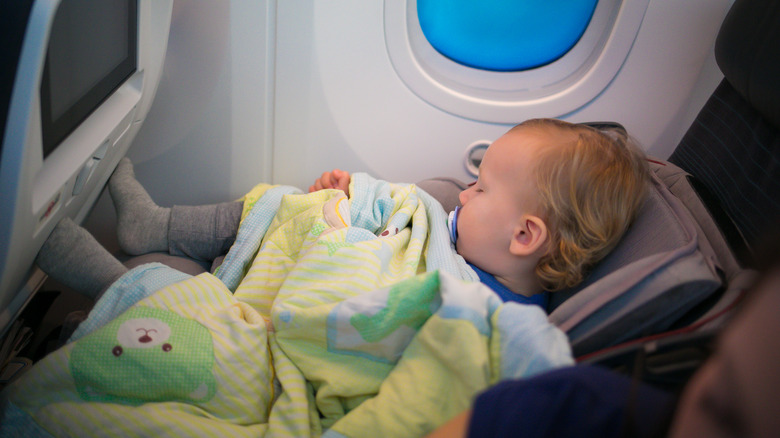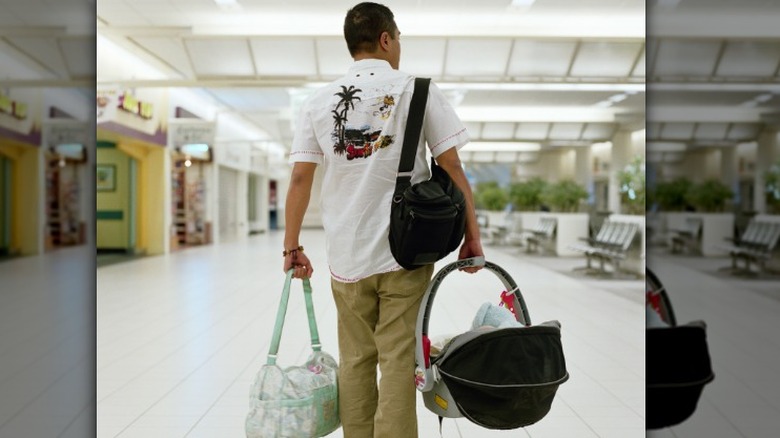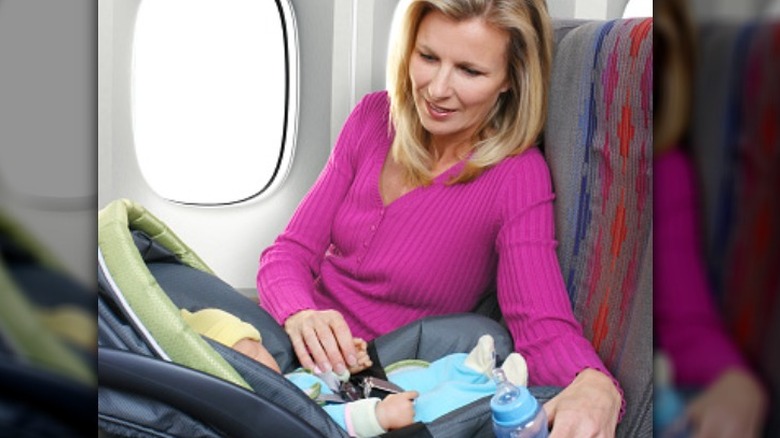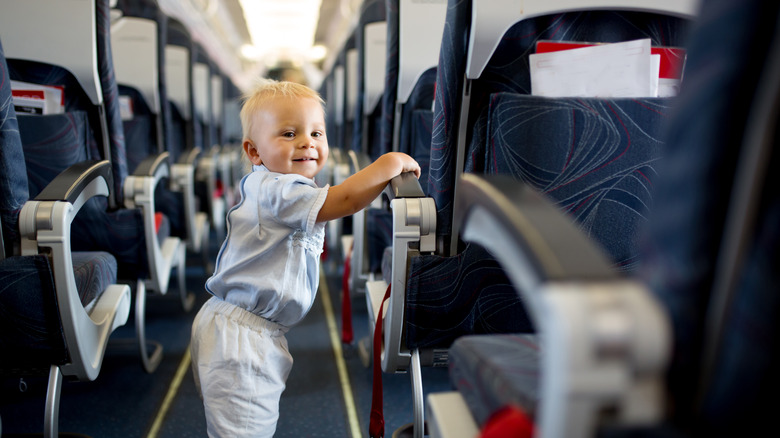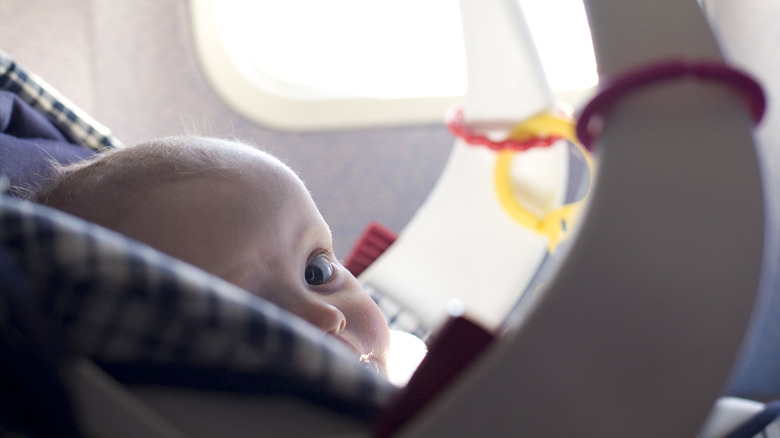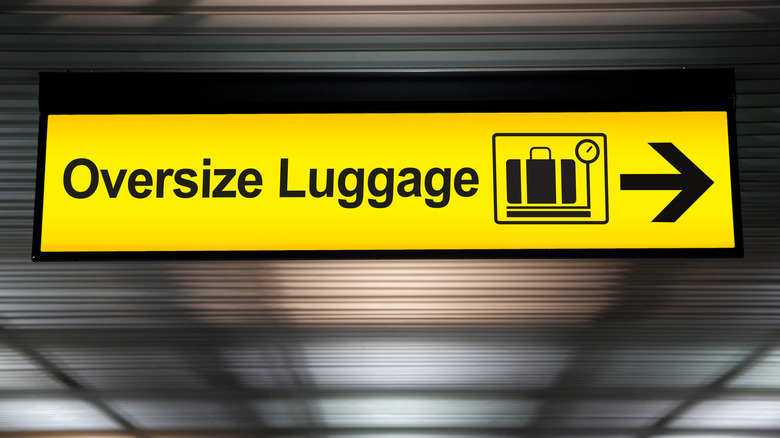Flying With A Car Seat? Here's What You Need To Know
You've probably already heard it but it bears repeating: Bringing a car seat for your baby on a flight is the safest way for your child to fly. And although it's not required by the Federal Aviation Administration (FAA), the agency strongly encourages parents to bring a car seat or other FAA-approved child restraint system or device when flying with young children. This means the car seat has the required label noting it is certified for use in motor vehicles and aircraft.
And, no, it's not enough to hold them in your lap, especially during turbulence, which is the leading cause of pediatric injuries on a plane, according to the FAA. As Sara Nelson, the international president of the Association of Flight Attendants-CWA, told The Washington Post, "We've seen airplanes go through turbulence recently and drop 4,000 feet in a split second. The G-forces are not something even the most loving mother or father can guard against and hold their child. It's just physically impossible." You'll also need your hands to put on your oxygen mask in cases of low cabin pressure.
So, yes, flying with a car seat is a good choice, especially if you're flying with a young child, i.e., under 2 years. But, if this is your first time flying with one, it's understandable that you have questions. We'll do our best to answer the most important queries you might have. So let's dive in.
Do you have to pay to bring a car seat on the plane?
Technically, no, but you'll have to hope and pray that there's an open seat and that the flight attendant will allow you to use it. Otherwise, you'll have to check your car seat and hold your child in your lap for the duration of the flight. In short, when you don't pay for a seat, there's no guarantee your child can sit securely in their car seat next to you during the flight.
Although paying for an extra seat can be hard on the budget, you should carefully consider it. Having peace of mind and assurance of your child's safety during the flight is priceless. Plus, if you have a toddler, a car seat can keep them behaved, and you stress-free. As a user commented in the Toddlers Reddit forum's car seat discussion: " ... [I]t's so nice to have her contained! Someone behind me was trying to get their toddler to sit down the whole flight and it sounded exhausting."
Which plane seat is the best for a car seat?
When you bring a car seat on a plane, your options for seating are limited. Of course, you should book adjoining seats. The FAA says not to put car seats in exit rows, and you should avoid rows in front of or behind exit rows as well. Additionally, a lot of airlines ask that you put a car seat in the window seat. Putting children in aisle seats can be dangerous due to the possibility of falling items from overhead compartments and hot beverages spilling from carts. But, if you're flying on an aircraft with two aisles, a middle seat in the center is a good option too. Basically, book a seat for your baby's car seat that won't hinder another passenger from exiting or accessing the aisle.
And, when booking first class and business class, check that your car seat can fit in the seats you book. Sometimes, these cabin seats have angles that won't fit a car seat. In fact, double-check your car seat's weight limitations and dimensions against your plane's seat — it should be no more than 16 inches wide for most airlines. However, if you find that your car seat doesn't fit the seat, the FAA requires your airline to find another seat where it will fit.
If in doubt or you have questions, reach out to your airline for confirmation and answers. Also check with your airline if they allow car seats in the bulkhead, as many don't. If they do, book seats there for more leg room.
How do you install a car seat on the plane?
Once on board the plane, your next agenda will be to install the car seat. While asking for the help of a flight attendant might sound like a good plan, don't rely on them. You are responsible for knowing how to install your car seat. The FAA has videos explaining the installation of forward-facing and rear-facing car seats, but it's always best to read the manual beforehand to be sure you're not going to break or damage anything.
If, after reading the manual, you have some questions, seek out the advice and expertise of a child passenger safety technician (CPST). You can search the National Child Passenger Safety Certification training program's website or the National Highway Traffic Safety Administration's online directory, or reach out to your local Safe Kids Coalition. Don't forget to have your child's weight and height info, your car seat's manual, and, if possible, your child, among other things during the checkup.
In general, you can install either a forward-facing or rear-facing car seat. First, locate the right belt path in your car seat, loosen the airplane seatbelt and get it through the belt path, and then buckle and tighten it. If you're using a rear-facing car seat, note that it will interfere with the recline function of the seat in front, so you might arrange for a companion to sit there, if you're traveling with one.
Should you buy a rear-facing or front-facing car seat?
There's no prohibition against any of these types of car seats. You can bring a front-facing or rear-facing car seat on a flight as long as it is installed in a forward-facing plane seat. According to BabyCenter, children below 20 pounds should be seated in a rear-facing car seat whereas children from 20 to 40 pounds should be seated in a forward-facing car seat.
With this in mind, infants and toddlers should generally use a rear-facing car seat, while children more than 3 years old and younger than 7 years old or who have reached the height and weight limits can be placed in a forward-facing car seat. Basically, your child's age, weight, and height will dictate what type of car seat they'll use.
As mentioned, the car seat you bring with you on a flight should be one that's FAA-approved, i.e., it should have the certification label required for air travel. You can find this in a sticker with red text. Make sure you know where it is before boarding the plane as flight attendants will look for this label upon boarding. If you don't know where it is and the flight attendant can't find it, you might be asked to check your car seat instead.
How do you check your car seat?
If shelling out those extra bucks just isn't in the budget, then you can check your car seat for free with most airlines. And whether you check it at the ticket counter or at the gate, remember to get your luggage tag, fill it out, and attach it to the car seat immediately. This way, you don't have to worry about it upon boarding.
If you gate check your car seat, you can drop it at the ramp right before boarding or a flight attendant will take care of it for you. Upon arrival, your car seat should be waiting for you at the jetbridge. If not, go to the baggage claim or ask a flight attendant about it.
If you check it at the counter, you might want to invest in a car seat travel bag. While this doesn't guarantee that your car seat won't be damaged, at least it will not be dirty. After deplaning, head to the oversized luggage section at the baggage claim area. You can usually claim car seats and strollers there, but call your airline to double-check. If you have a connecting flight, ensure you have time to retrieve your luggage, get to your next flight, and install the car seat there. Also, have a plan B in case your car seat gets damaged or lost. This typically means buying a new one or renting, so research in advance to prepare for the worst-case scenario.
